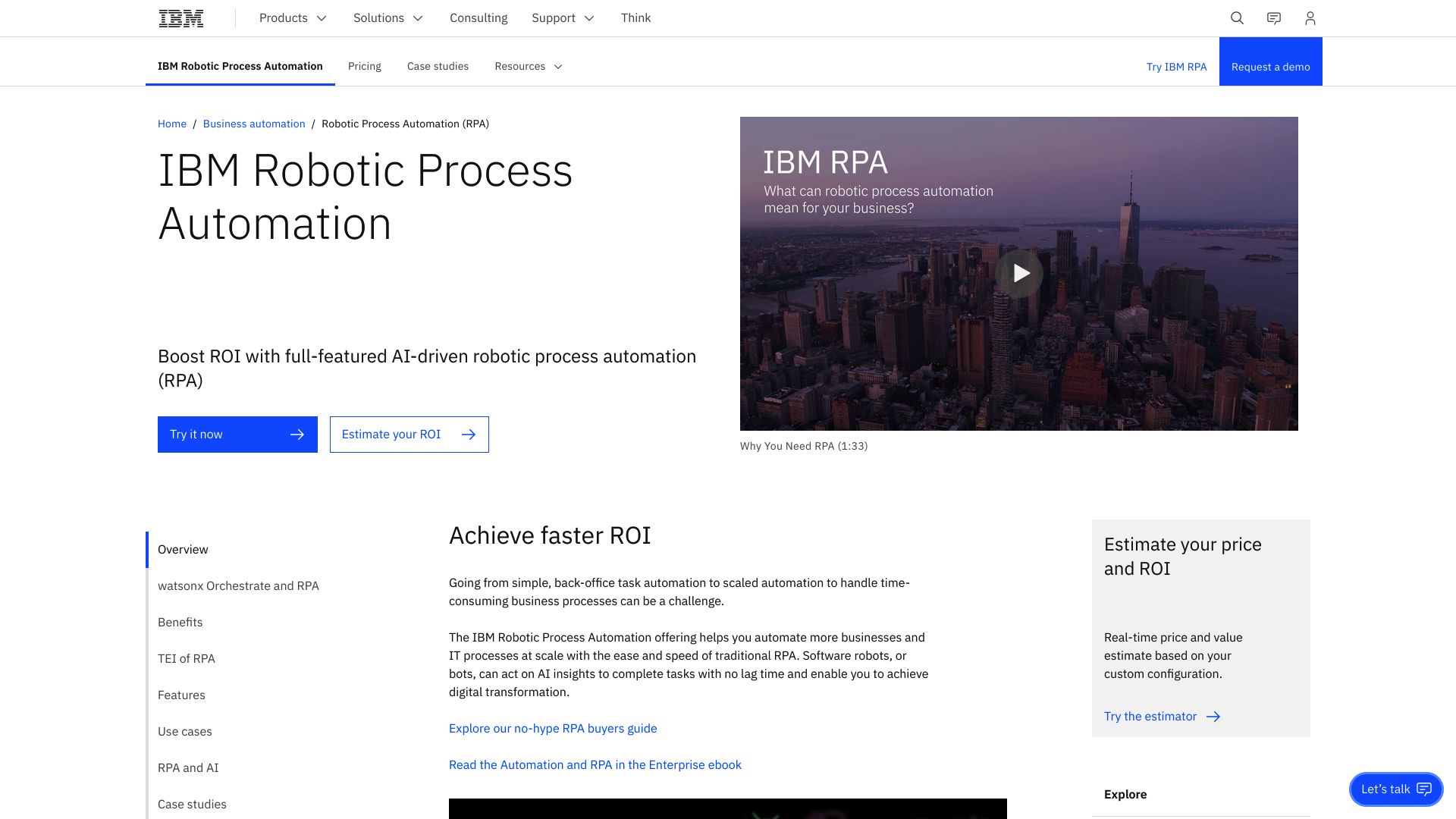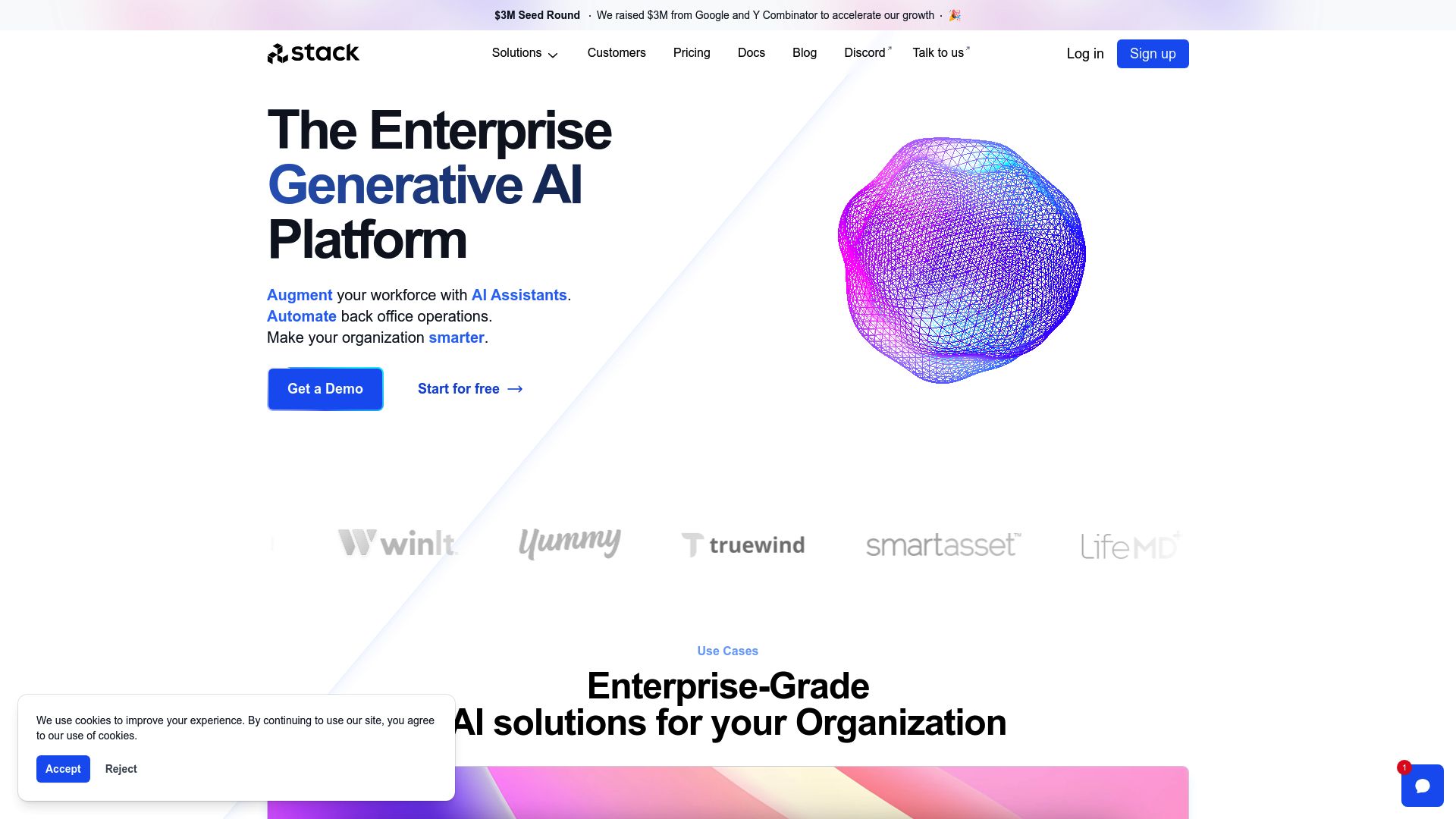IBM RPA vs. Stack AI: Comparing Enterprise Automation Solutions
AI-powered automation transforms business operations, promising enhanced efficiency and innovation. As organizations seek the ideal solution, IBM RPA vs. Stack AI, and SmythOS emerge as notable contenders. This comparison delves into their unique features, exploring how each platform tackles enterprise automation, AI accessibility, and scalability.
We’ll uncover how IBM RPA’s robust enterprise tools, Stack AI’s no-code simplicity, and SmythOS’s versatile capabilities cater to diverse organizational needs. By examining their strengths and limitations, we aim to guide decision-makers, developers, and business leaders in selecting the most suitable AI automation platform for their specific requirements.
IBM RPA Overview
IBM RPA empowers businesses to automate repetitive tasks and streamline operations through intelligent software robots. These bots interact with applications and systems, mimicking human actions to execute processes efficiently and accurately.


IBM RPA offers a comprehensive suite of tools for building, deploying, and managing automation workflows. Its low-code visual builder enables both technical and non-technical users to create bots using drag-and-drop functionality and pre-built commands. This accessibility democratizes automation, allowing organizations to rapidly develop and implement solutions across departments.
IBM RPA offers a comprehensive suite of tools for building, deploying, and managing automation workflows. Its low-code visual builder enables both technical and non-technical users to create bots using drag-and-drop functionality…
The platform supports both attended and unattended bots, catering to various automation needs. Attended bots work alongside humans, augmenting their capabilities, while unattended bots operate autonomously, handling high-volume, repetitive tasks without human intervention. IBM RPA’s integration with watsonx Orchestrate further enhances its capabilities, incorporating AI-driven decision-making and natural language processing into automation workflows.
While IBM RPA offers robust features, its enterprise focus may present a steeper learning curve for smaller organizations or individual users. The platform’s strength lies in its scalability and integration capabilities, making it particularly well-suited for large-scale deployments in complex IT environments. However, this enterprise-grade functionality may come at the cost of agility and quick deployment for simpler use cases.
IBM RPA seamlessly integrates with a wide range of enterprise systems, including mainframes, APIs, and desktop applications. This versatility allows organizations to create end-to-end automation solutions that span multiple systems and departments. The platform’s commitment to security and governance is evident through its integration with IBM OpenPages, ensuring compliance and maintaining audit trails for all automated processes.
Stack AI Overview
Stack AI empowers users to build and deploy AI-powered workflows and custom assistants without extensive coding. The platform’s no-code interface democratizes AI development, enabling organizations to leverage advanced capabilities for enhanced efficiency and decision-making.


Stack AI empowers users to build and deploy AI-powered workflows and custom assistants without extensive coding. The platform’s no-code interface democratizes AI development…
Stack AI’s visual builder facilitates the creation of AI agents through an intuitive drag-and-drop interface. Users can customize pre-built templates for common use cases or design unique solutions from scratch. The platform supports integration with various data sources and services, including Google Drive, Salesforce, and Slack, expanding its utility across diverse business environments.
Security stands out as a key feature, with Stack AI boasting enterprise-grade compliance certifications such as SOC 2, HIPAA, and GDPR. This focus on data protection instills confidence for businesses handling sensitive information. The platform also offers flexible deployment options, allowing users to implement AI solutions through customizable interfaces or API endpoints.
While Stack AI simplifies AI development, it may present challenges for users seeking highly specialized functionalities beyond the platform’s pre-built options. Additionally, as with many no-code solutions, advanced users might find limitations in fine-tuning AI models compared to traditional coding approaches. Despite these potential drawbacks, Stack AI’s combination of accessibility, security, and integration capabilities positions it as a valuable tool for businesses looking to harness AI without extensive technical resources.
Feature Comparison
IBM RPA and Stack AI offer distinct approaches to automation and AI development, each with its own strengths and limitations. IBM RPA excels in enterprise-grade automation, providing robust tools for building and managing software bots across large organizations. Its integration with Watson AI enhances cognitive capabilities, enabling bots to handle complex, knowledge-based tasks. However, IBM RPA’s enterprise focus may present a steeper learning curve for smaller organizations or individual users.
Stack AI, on the other hand, emphasizes accessibility and rapid development of AI-powered workflows through its no-code interface. This approach democratizes AI creation, allowing users without extensive coding knowledge to build custom AI assistants. While this accessibility is a significant advantage, it may limit the depth of customization available to advanced users compared to more code-centric platforms.
In terms of security and compliance, both platforms offer strong features, but with different emphases. IBM RPA integrates with IBM OpenPages for governance and audit trails, crucial for highly regulated industries. Stack AI boasts enterprise-grade security certifications like SOC 2 and HIPAA compliance, making it suitable for handling sensitive data across various sectors. However, IBM RPA’s long-standing presence in enterprise environments may provide a more comprehensive suite of security tools and integrations.
SmythOS bridges these gaps by offering a platform that combines the accessibility of no-code development with the power of enterprise-grade AI capabilities. It provides a visual builder for creating complex AI workflows, supports multi-agent collaboration, and offers flexible deployment options, including API endpoints and chatbots. SmythOS also emphasizes scalability and integration, allowing for seamless connections with various data sources and services. This versatility, combined with robust security features and support for advanced AI models, positions SmythOS as a comprehensive solution that addresses the limitations of both IBM RPA and Stack AI.
Feature Comparison Table
| IBM RPA | Stack AI | SmythOS | |
|---|---|---|---|
| CORE FEATURES | |||
| AI Agents | ❌ | ✅ | ✅ |
| Memory & Context | ❌ | ✅ | ✅ |
| Autonomous Agents | ❌ | ✅ | ✅ |
| Explainability & Transparency | ❌ | ✅ | ✅ |
| Multimodal | ❌ | ✅ | ✅ |
| Problem-Solving Capabilities | ❌ | ✅ | ✅ |
| Multi-Agent Collaboration | ❌ | ✅ | ✅ |
| Work as Team | ❌ | ✅ | ✅ |
| SECURITY | |||
| Constrained Alignment | ❌ | ❌ | ✅ |
| OAuth | ❌ | ✅ | ✅ |
| IP Control | ❌ | ❌ | ✅ |
| COMPONENTS | |||
| Foundation AIs | ❌ | ✅ | ✅ |
| Huggingface AIs | ❌ | ❌ | ✅ |
| Zapier APIs | ❌ | ✅ | ✅ |
| Classifiers | ❌ | ✅ | ✅ |
| Data Lakes | ❌ | ✅ | ✅ |
| DEPLOYMENT OPTIONS (EMBODIMENTS) | |||
| Deploy as Webhook | ❌ | ✅ | ✅ |
| Staging Domains | ❌ | ✅ | ✅ |
| Production Domains | ❌ | ✅ | ✅ |
| API Authentication (OAuth + Key) | ❌ | ✅ | ✅ |
| Deploy as Site Chat | ❌ | ✅ | ✅ |
| Deploy as Scheduled Agent | ✅ | ❌ | ✅ |
| Deploy as GPT | ❌ | ✅ | ✅ |
| DATA LAKE SUPPORT | |||
| Hosted Vector Database | ❌ | ✅ | ✅ |
| Sitemap Crawler | ❌ | ❌ | ✅ |
| YouTube Transcript Crawler | ❌ | ❌ | ✅ |
| URL Crawler | ❌ | ✅ | ✅ |
Best Alternative to IBM RPA and Stack AI
SmythOS emerges as a superior alternative to IBM RPA and Stack AI, offering a comprehensive platform for creating and managing AI agents. Our solution combines the power of enterprise-grade automation with the accessibility of no-code development, addressing limitations found in both IBM RPA and Stack AI.
We provide a visual drag-and-drop interface that simplifies the creation of complex AI workflows, making advanced AI capabilities accessible to users across technical skill levels. Unlike IBM RPA’s steep learning curve or Stack AI’s limited customization options, SmythOS strikes an optimal balance between ease of use and powerful features.
SmythOS emerges as a superior alternative to IBM RPA and Stack AI, offering a comprehensive platform for creating and managing AI agents.
Our platform excels in multi-agent collaboration, enabling teams of AI agents to work together on sophisticated tasks. This capability surpasses both IBM RPA’s focus on individual bots and Stack AI’s more limited AI assistant approach. SmythOS supports a wide range of AI models and integrations, including those from OpenAI, Anthropic, and Hugging Face, providing unparalleled flexibility in AI development.
SmythOS offers versatile deployment options, including API endpoints, chatbots, and scheduled agents. This flexibility allows for seamless integration into existing systems and workflows, addressing a key limitation of both IBM RPA and Stack AI. Our platform’s scalability ensures that solutions built with SmythOS can grow alongside your business needs, from small-scale projects to enterprise-wide implementations.
With robust security features, including constrained alignment and IP control, SmythOS prioritizes data protection and compliance. We offer a comprehensive solution that combines the best aspects of automation and AI development, making it the ideal choice for businesses seeking to leverage AI technology effectively and efficiently.
Conclusion
IBM RPA, Stack AI, and SmythOS each offer unique approaches to automation and AI development, catering to different organizational needs and technical expertise levels. IBM RPA excels in enterprise-grade automation, providing robust tools for large-scale deployments and complex IT environments. Stack AI emphasizes accessibility with its no-code interface, enabling rapid AI-powered workflow creation. However, SmythOS emerges as the superior option, combining the strengths of both while addressing their limitations.
SmythOS stands out with its comprehensive feature set, blending enterprise-grade capabilities with user-friendly design. Its visual builder facilitates complex AI workflow creation without sacrificing depth, appealing to both technical and non-technical users. The platform’s support for multi-agent collaboration, extensive integrations, and flexible deployment options surpass the offerings of IBM RPA and Stack AI. SmythOS’s ability to handle multimodal interactions and its robust problem-solving capabilities position it as a versatile solution for diverse business needs.
While IBM RPA and Stack AI have their merits in specific scenarios, SmythOS’s adaptability and scalability make it the ideal choice for organizations looking to fully leverage AI across their operations. Its emphasis on security, transparency, and customization addresses the concerns of both enterprise clients and smaller teams seeking powerful AI solutions.
For those ready to experience the next level of AI automation, we invite you to explore SmythOS’s diverse range of AI-powered agent templates. These templates offer a quick start to revolutionizing your workflow across various business functions. To dive deeper into SmythOS’s capabilities and see how it can transform your AI initiatives, create a free SmythOS account and start building unlimited AI agents at no cost. With SmythOS, you’re not just adopting a tool; you’re embracing the future of AI-driven productivity and innovation.
Last updated:
Disclaimer: The information presented in this article is for general informational purposes only and is provided as is. While we strive to keep the content up-to-date and accurate, we make no representations or warranties of any kind, express or implied, about the completeness, accuracy, reliability, suitability, or availability of the information contained in this article.
Any reliance you place on such information is strictly at your own risk. We reserve the right to make additions, deletions, or modifications to the contents of this article at any time without prior notice.
In no event will we be liable for any loss or damage including without limitation, indirect or consequential loss or damage, or any loss or damage whatsoever arising from loss of data, profits, or any other loss not specified herein arising out of, or in connection with, the use of this article.
Despite our best efforts, this article may contain oversights, errors, or omissions. If you notice any inaccuracies or have concerns about the content, please report them through our content feedback form. Your input helps us maintain the quality and reliability of our information.
